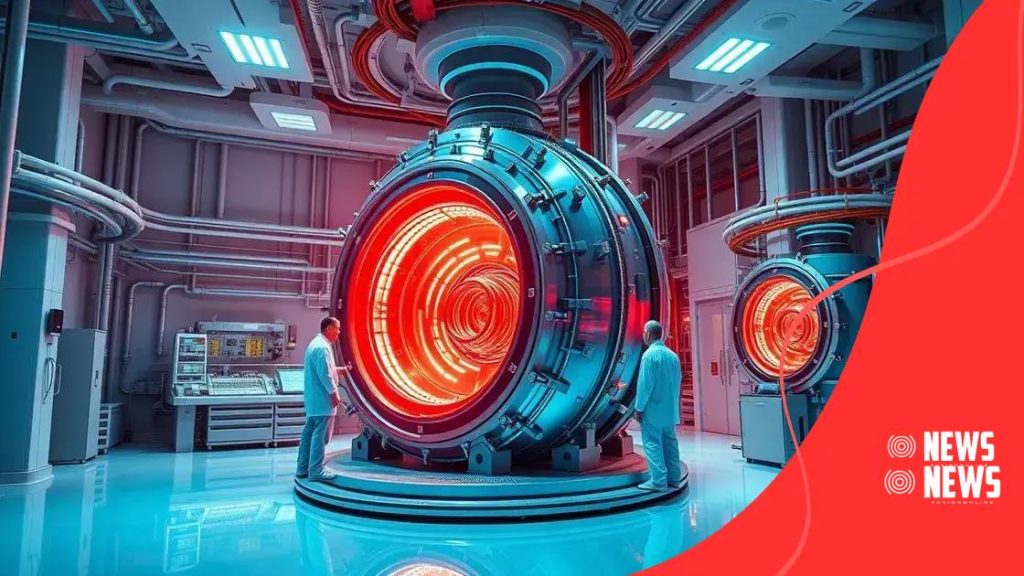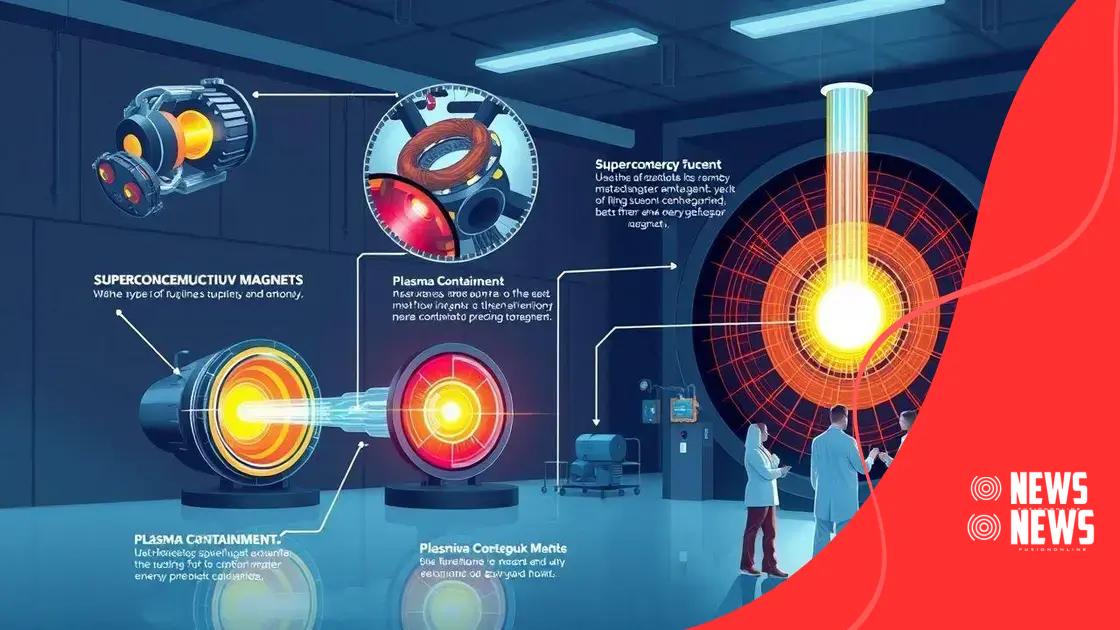The race for fusion energy: powering sustainable innovation

Fusion energy combines light atomic nuclei to generate vast amounts of energy with minimal waste, making it a clean and sustainable alternative to fossil fuels.
The race for fusion energy is not just about scientific achievement; it’s about securing a sustainable future for our planet. Imagine a world where clean energy is limitless and ever-present. Sounds intriguing, right? Let’s dive into the possibilities.
What is fusion energy and why does it matter?
Fusion energy is the process that powers the sun and other stars. It occurs when two light atomic nuclei combine to form a heavier nucleus, releasing a tremendous amount of energy. This process is considered a cleaner and more sustainable energy source compared to traditional methods.
Understanding fusion energy is essential, especially as we face growing demands for power and the impacts of climate change. By harnessing this form of energy, we could potentially meet our energy needs without the harmful emissions produced by fossil fuels.
How does fusion work?
Fusion combines light elements, usually isotopes of hydrogen, such as deuterium and tritium. When these atomic nuclei are heated to extremely high temperatures, they collide with enough energy to overcome their natural repulsion, allowing them to fuse together.
Why fusion energy matters?
The significance of fusion energy lies in its potential advantages:
- It produces minimal long-lived radioactive waste.
- It has an almost limitless fuel supply from seawater.
- It can operate safely without the risk of catastrophic failure.
As we explore safer, cleaner alternatives to fossil fuels, fusion energy stands out as a viable candidate. While we are still in the experimental stages of developing fusion reactors, advances in technology suggest a promising future. Researchers worldwide are investing time and resources to make fusion energy a reality.
Even though fusion energy has challenges, such as achieving and maintaining the necessary conditions for fusion, the benefits far outweigh these hurdles. Tackling these challenges could lead to revolutionary changes in how we think about energy production.
How fusion differs from fission and other energy sources
Fusion and fission are two distinct processes for generating energy, and understanding how they differ is crucial. While both involve atomic reactions, their mechanisms and outcomes vary significantly. Fission, the splitting of heavy atomic nuclei, releases energy but also produces hazardous waste. In contrast, fusion combines light nuclei to create a heavier nucleus, offering a cleaner energy source.
Fusion produces energy under conditions similar to those in the sun. It has the potential to generate immense amounts of energy without the long-lived radioactive waste associated with fission. This fundamental difference highlights a key advantage of fusion over fission.
Key differences between fusion and fission
- Process: Fusion merges light elements like hydrogen, while fission splits heavy elements like uranium.
- Energy output: Fusion produces more energy per reaction than fission.
- Waste products: Fusion produces minimal waste compared to the hazardous byproducts of fission.
- Safety: Fusion carries a lower risk of catastrophic accidents since it requires precise conditions to sustain reactions.
In comparison to other energy sources, such as natural gas or coal, the advantages of fusion energy become even more apparent. Fossil fuels not only contribute to greenhouse gas emissions but also deplete natural resources. In contrast, fusion relies on isotopes found in seawater, making it virtually limitless. This potential aligns well with the global need for sustainable energy solutions.
The difference between fusion and traditional renewable sources, like solar and wind, lies in the scale and consistency of energy production. While solar and wind are intermittent, fusion could provide a stable and continuous power supply, representing a major leap forward in energy technology.
Current breakthroughs in fusion energy technology

There are exciting current breakthroughs in fusion energy technology that promise to accelerate our journey toward sustainable power. Researchers worldwide are making significant strides, and these innovations are vital for making fusion a practical energy source.
One notable advancement involves improved magnetic confinement techniques. Scientists are utilizing advanced superconducting magnets to achieve higher temperatures and pressures necessary for fusion. This breakthrough helps create stable plasma conditions, which are crucial for successful fusion reactions.
Prominent fusion projects
Several key projects are making progress in fusion energy:
- ITER: Located in France, this international project aims to demonstrate the feasibility of fusion energy on a large scale.
- SPARC: Developed by MIT, this compact fusion reactor seeks to achieve net positive energy from fusion.
- Helion Energy: This private company is working on fusion reactors that could power homes and businesses efficiently and cleanly.
In addition to these projects, enhanced computational models and simulations are helping scientists understand plasma behavior better. The use of AI in predicting outcomes and optimizing reactor conditions is another exciting area. By employing machine learning, researchers can analyze vast amounts of data quickly, making adjustments in real time.
As these breakthroughs unfold, there is hope that fusion energy can become a viable alternative to fossil fuels. The race for sustainable energy is on, and the advancements in technology are paving the way for lasting change.
Challenges in achieving practical fusion energy
Despite the many advantages of fusion energy, there are significant challenges in achieving practical applications. These obstacles must be addressed to realize the full potential of this energy source. One major challenge is reaching the necessary conditions for fusion.
Fusion requires extremely high temperatures and pressures to occur. The temperatures need to exceed 150 million degrees Celsius, far hotter than the core of the sun. Maintaining such conditions in a controlled environment is a complex task that researchers are still working to optimize.
Key challenges in fusion energy
Several critical issues stand in the way of successful fusion:
- Plasma confinement: Keeping the hot plasma stable and contained is vital for sustaining fusion reactions. Current technologies are developing but still need improvements.
- Materials durability: The materials used in fusion reactors must withstand extreme heat and radiation, which poses difficulties in material science.
- Energy input vs. output: Achieving a net positive energy output remains a challenge. The energy needed to create and maintain fusion must be less than the energy produced.
- Funding and investment: Fusion projects require substantial financial resources and long-term commitment since development can take decades.
Each of these challenges represents a crucial area of focus for scientists and engineers. Ongoing research seeks to innovate solutions that can overcome these barriers. By addressing these issues methodically, the dream of fusion energy can transform from theory into reality.
While progress is being made, a collaborative global effort involving public and private sectors will be key to tackling these challenges effectively. With continued determination, the goal of practical fusion energy is within reach.
The future of energy: Fusion’s role in sustainability
The future of energy is bright, and fusion is poised to play a vital role in achieving sustainability. As the world looks for cleaner energy sources, fusion energy offers a solution that could meet our growing demands while minimizing environmental impact.
Unlike fossil fuels, fusion produces energy without harmful emissions. This cleaner process can help reduce greenhouse gases, a crucial factor in combating climate change. With resources that can be derived from seawater, fusion offers a nearly unlimited fuel supply.
Key aspects of fusion’s role in sustainability
Fusion energy contributes to sustainability in several ways:
- Reduced waste: Fusion produces minimal long-lived radioactive waste compared to fission, making it safer for the environment.
- Constant energy supply: Unlike solar or wind energy, which are intermittent, fusion has the potential to provide a stable and reliable energy source.
- Lower resource depletion: With abundant fuel sources, fusion can help avoid the depletion of fossil fuels and other limited resources.
As nations seek to transition toward greener energy, investment in fusion technology will be crucial. Public and private sectors must collaborate to develop this promising energy source. With continued research, fusion energy can become a cornerstone of our future energy systems.
Innovations in fusion technology could revolutionize the way we generate power. As scientists and engineers tackle the remaining challenges, the path to a sustainable future with fusion energy is becoming clearer.
FAQ – Frequently Asked Questions about Fusion Energy
What is fusion energy?
Fusion energy is the process of combining light atomic nuclei to form a heavier nucleus, releasing a large amount of energy in the process.
How does fusion differ from fission?
Fusion combines light elements like hydrogen, whereas fission splits heavy elements like uranium. Fusion produces less waste and is generally safer.
What are the main challenges in achieving practical fusion energy?
Key challenges include maintaining the extremely high temperatures needed, ensuring plasma confinement, and achieving a net positive energy output.
Why is fusion energy considered sustainable?
Fusion energy is sustainable because it produces minimal waste, relies on abundant fuel sources, and results in no harmful emissions.





